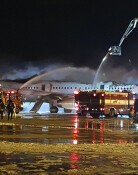Ignoring danger signals resulted in casualties
Ignoring danger signals resulted in casualties
Posted January. 02, 2025 07:45,
Updated January. 02, 2025 07:45
The causes behind the Jeju Air accident at Muan International Airport, in which 179 people lost their lives, are being unveiled. The aircraft attempted an emergency landing immediately after a bird strike but skidded off the runway and hit a concrete wall where a localizer antenna was installed, bursting into a fireball.
The airport has a longitudinal safety area for ‘overruns’ to which aircraft move when they run off the runway. Rules stipulate that installations inside the area must be made of fragile materials. The Ministry of Land, Infrastructure and Transport has argued that this regulation does not apply to the Muan Airport localizer because it was installed approximately 5 meters outside the safety zone. However, the Ministry of Land, Infrastructure, and Transport's notice clearly states that the safety area includes the area where the localizer antenna is installed and the concrete wall should not have been erected.
The 2,800-meter runway was shortened by about 300 meters due to runway extension construction. The airport reduced the runway to secure a safety zone. The collision might have been avoided if the runway and safety zone had been sufficiently secured, as the aircraft would have been able to reduce speed.
Why the concrete wall was constructed in the first place remains a mystery. It is presumed that the airport might have been trying to level out the sloping terrain, but it was erected with a raised shape of about 2 meters. The approach lights, which need to be installed separately from the localizer, were installed in a disorganized way.
Muan Airport is ranked first among 14 domestic airports in Korea in terms of bird collision ratio (0.09%) against the number of flights. The Muan Airport Bird Collision Prevention Committee Meeting, held 10 days before the disaster, had expressed concern that bird dispersal and capture performance had decreased by 14.4% compared to the previous year due to a lack of manpower and vehicles. Despite such concerns, only one person was working at the scene at the time of the accident.
Circumstances suggest that massive casualties could have been avoided if more efforts had been made to chase birds away, if there had not been a concrete wall, and if runway length and safety zone had been sufficiently secured. There had been signals warning of danger, which were ignored. Lack of caution was the main driver of the disaster.







